Last year our Salvia hive, sourced from a feral swarm that landed in a neighbor’s plum tree, was the most populous, and robust hive in our apiary.
This colony was doing so well that we split the hive in February to replace one of the colonies we’d lost over winter when the hive collapsed, and the Queen flew off. By dividing the hive we would be selecting for the Salvia Queen’s strong genetics, and hoped to build up another equivalently strong colony.

By dividing our healthy hives in late winter, were able to replace colonies that had not survived (click any image to enlarge)
Salvia’s daughter colony from that split is this year’s Rosemary colony, and I’m happy to say that this weekend we found that Rosemary is every bit as formidable, and strong, as Salvia was last year.
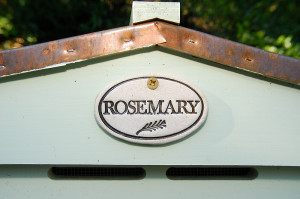
The Rosemary Queen is a daughter of last year’s Salvia Queen, and this is now a very strong, and somewhat aggressive colony
Weather permitting, we’ll definitely make early season splits when we can in the future, as this hive has built up very well through the season.
We hoped splitting the Salvia colony would also prevent it from swarming, but we weren’t expecting the hive to rebound so quickly after the split, and Salvia swarmed anyway.
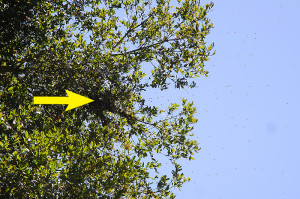
Despite splitting the Salvia colony, the Salvia Queen swarmed a few weeks later, taking thousands of bees, and most of the honey, with her
Establishing Salvia 2.0
After the Salvia hived swarmed we did a post-swarm inspection and were surprised to see that there was no brood left in the Salvia hive after the Queen and her entourage flew off. There were plenty of worker bees, and a few drones, but no brood.
Most importantly, there were no eggs, and without newly laid eggs, there was no possibility of the colony being able to raise a new emergency Queen.
If we did nothing, this colony was doomed to fail, so we intervened.

By early spring the Lavender hive was also very strong, and swarmed 2 weeks after we’d split this hive
To give the remaining bees in the Salvia hive a chance to survive the season we transferred a frame with newly laid eggs from the neighboring Lavender hive, which had also recently swarmed. That colony had 9 capped Queen cells, and plenty of brood resources, so we also transferred a few frames of capped brood, and some capped Queens cells (as insurance) into the broodless Salvia colony.
After six weeks, we rechecked Salvia and found capped worker brood in the hive, which told us we indeed had succeeded in helping Salvia to produce a new healthy laying Queen. It appeared the Salvia colony was saved.
Over the spring and summer months all the colonies built up, and overall the hives in our apiary have been much stronger than last year. The weather was more normal this year, less wet and cold, and we’ve had no need to feed the bees this season, as they’ve all been doing fine on their own.
However, a few weeks ago something had changed.
Late Summer Population Decline
We’ve tried to be much less intrusive with our hive inspections this year. Now we have more experience under our belt, we’re much more comfortable observing the hive entrances to help gauge the general status of a colony.
Other than checking on honey stores, we’ve largely left the hives alone through summer.
A few weeks ago it seemed that entrance activity, relative to the other colonies, was declining in front of the Salvia hive. Fewer bees per minute were leaving and entering, fewer bees were clustering near the entrance on a hot afternoon. The hive just seemed sluggish compared to the others.
As the apiary is above the garden, I have a lot of opportunity to keep an eye on the comings and goings in front of the hives, and by last week I was starting to get very concerned. A small hive split, from the Lavender hive, was positioned on the hive stand right next to the Salvia hive.
It was evident that entrance activity in front of the 15 frame nuc was more than the large Salvia hive next to it. Clearly, something was amiss with Salvia. Her population was crashing, the question was, why?
There is a decline in colony population that naturally occurs in late summer to early fall. Nectar resources dwindle, drones are pushed out of the hive, and as we head toward fall, the colonies contract in preparation for winter. That’s normal.
All of the colonies in our apiary have lost a little population in recent weeks, but not nearly as much as Salvia.
On Sunday, as we prepared to inspect the Salvia colony, we also planned, if needed, to combine the small nuc colony with the Salvia hive to help increase their population for the fall. Combining colonies is relatively straightforward, and late summer to early fall is the time to combine weak hives together to ensure they have sufficient resources, and population, to survive the winter months.
In case we needed to combine hives, we made sure we had our trusty Queen catcher handy, and a few sheets of newspaper. I’ll explain the purpose of the newspaper in a moment.
Inspecting the Hive for Answers
We pulled the lid off the Salvia hive first to see what was going on. There were more bees clustered at the top than we expected to see, but there was honey in the top super, so that’s not surprising.
We pulled off the top super, which was mostly honey, and found the box below was mostly empty, both of honey, and of bees.
The next tier down we found a few bees, and five of the eight frames seemed to have capped honey.
As we pulled the frames though, we had a surprise at the bottom of one of them.
Not only did we find a Queen cup, this cup contained an egg, that seemed to have been laid within the last 48 hours.
We weren’t terribly surprised to find this, in that late summer is a time when colonies may choose to replace weak Queens. Without a strong Queen, the colony may not have sufficient winter bees to survive the coming months. Colonies need their Queens to be strong before the cold winter weather sets in, to have the best chance of surviving until spring.
For beekeepers Queen Cups and Queen Cells are just something to watch for. The presence of this cup, with an egg, suggested that for whatever reason, this colony needs to produce a new Queen. As they weren’t in the least bit crowded, we presumed they weren’t creating this new Queen to swarm.
We had already inspected the other hives in our apiary the day before, and like this time last year, there was already a marked absence of drones. Without drones in the area we were concerned that any new Queen produced at the moment would run the risk of being poorly mated. However, we still didn’t really know what was going on in this hive.
We moved down to the next hive body, which is where we found most of the bees.

We finally found a larger group of worker bees, and expected this would be the hive body where the brood nest was
We were hoping to find some capped worker brood, but it was almost immediately obvious that there was none. This colony seemed to be completely broodless. This left us with more questions than answers.
What had happened to the Queen in this hive? Why was she not producing brood? When did she cease producing brood? Was she injured? Did she abscond? Was the Queen dead?
In an effort to find some answers, we had to look more closely. We scrutinized the frames in the bottom two hive bodies. We had to see if there were eggs. Someone laid that egg in the Queen Cup. Surely that can’t be the only egg in the entire hive!
The answer to whether the Queen was alive, would be to see her. Try as we might, we could not find her. If she was in this hive, we missed her.
Finally, we found a frame with some brood, but it was only a smattering of drone brood. What was there seemed to be clustered together, more or less as we’d expect. Not a stellar pattern, but not the worst we’ve ever seen.
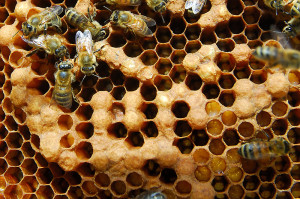
Just this one frame contained any brood, and it was all drone brood, along with a few (presumably) drone larvae
The fact there was any drone brood was notable though, because none of our other hives had any drones, or drone brood at all when we’d checked those hives the day before. As drones take longer than worker bees to hatch, at first we thought maybe these were just from some of the last eggs the Queen had laid. However, only finding drones in a hive could suggest the Queen is infertile, or missing, and that a worker bee has started to lay eggs.
A Failing Queen, or Laying Worker Colony?
We started to wonder if this colony was completely Queenless. In the absence of a Queen, one or more worker bees may start to lay eggs, but they can only lay unfertilized eggs, and only produce drones. That could explain the drone brood, and perhaps even the egg in the Queen Cup. However, if the egg in the Queen cup is a drone egg, this colony will fail to produce a new Queen.
If this was now a laying worker colony, where workers are laying eggs in the absence of a Queen, we had a big problem. Not just because laying workers can only produce drones.
Managing a laying worker colony, versus managing a colony with a weak or infertile Queen, is completely different. Before we could proceed we had to figure out which situation we were dealing with.
Laying worker colonies typically will kill any new Queen that is introduced to them. Even if when the Queen is introduced, she’s in a Queen cage. They’ll just kill her in her cage.
There are ways to try to encourage a laying worker colony to accept a new Queen, but it’s very time consuming, and requires repeated trips back to the hive, and a source of eggs and larvae (from another colony). The idea is, you keep giving the laying worker colony quality fertilized eggs, over a period of a few weeks, and eventually they (may) choose to raise their own new Queen. As soon as they produce a Queen Cell, a new mated Queen can be introduced to that colony instead to speed up the time to egg laying. However, this method is not always successful. The laying workers may simply persist, to their own detriment.
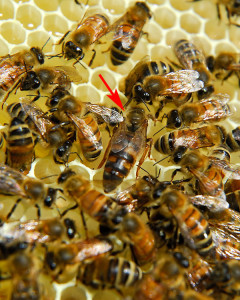
Laying worker colonies are difficult to manage, and any new Queen introduced to that colony may be killed
Most beekeepers instead of trying to introduce a new Queen to a laying worker colony, will simply shake out the bees, and take the hive away. The workers will either try to find another hive to enter, or not survive. Then once those bees have dispersed in a week or so, the hive can be put back, and populated with a new healthy colony of bees (from a package, or a split) with a new mated Queen. There were still a LOT of bees in the Salvia hive, and the thought of shaking them all out on the ground was daunting.
However, if we simply were dealing with a failing Queen, one that perhaps wasn’t well mated to start with, and was simply no longer capable of laying fertilized eggs, that situation is much easier to address. Often it just requires removing the weak Queen, and introducing a new mated Queen.
So which situation did we have?
Signs that a colony has laying workers in the hive are:
- Capped drone brood with an absence of worker brood
- Many individual cells containing multiple eggs (may be 3 or more eggs per cell)
- Eggs deposited on the side of the cell walls
- A haphazard laying pattern, with eggs anywhere on a frame
Laying workers don’t tend to lay eggs in the same typical brood pattern that Queens do. They don’t care where they lay them. They frequently lay three or more eggs in a single cell, but as their abdomens are short, they often can’t deposit the egg on the cell floor.
Signs that a colony has a failing Queen:
- Capped drone brood with an absence of worker brood
- Occasional cells with multiple eggs (most often less than 3 eggs per cell)
- Eggs deposited on the cell floor
- Eggs deposited in a normal egg-laying pattern, clustered in the brood area
A failing Queen doesn’t really change her laying pattern, she just can no longer produce worker (female) offspring. She may occasionally lay more than one egg in a cell, but generally not more than two.
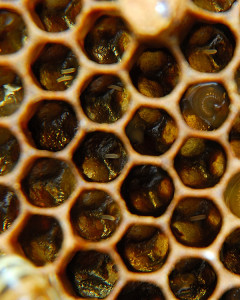
The eggs we found had been laid on the cell floor, but there were rare cells with two eggs in them (upper left)
Of course, there can always be exceptions, as bees are dynamic organisms and follow their own rules, not those of beekeepers, but using this general guideline, we felt it was more likely we were simply dealing with a failing Queen.
Salvaging the Salvia Colony…Again!
For the second time this year, we needed to rescue this hive. At this point we were very relieved that we had the extra nuc colony to source our new Queen from.
The nuc was made from the Lavender hive earlier this season. We’d run out of room on the hive stand, so we had maintained this colony in what had started as a 10 frame medium nuc, but by early summer they needed more room, so we added an extra nuc hive body to this colony to hold them over a little longer.
It’s fair to say on Sunday the nuc colony was a little crowded. We knew we needed to either rehome this colony into a larger hive, or sell it, so the timing of Salvia’s demise was perfect.
So, based on our findings, we presumed we had a failing Queen in this colony. We decided our best option was to combine what was left of Salvia with the healthy nucleus colony from Lavender.
We assumed the queen was still somewhere in the Salvia hive, and that we’d just failed to find her. Ideally, we would have located her, and removed her from the hive.
Even if we had done that though, we would still need to convince Salvia’s workers to accept a new Queen. We can’t simply dump a box of bees from one colony into another hive, and expect it to go well!
This is where the newspaper comes in.
The simplest method of combining colonies is to place one on top of the other, with a single layer of newspaper between the new colony and the old one.
Ideally, the strongest colony, with the healthiest Queen, should be placed above the weak colony. If there is still a Queen in the weak colony, more often than not the Queen in the colony at the top of the hive is considered to be more likely to win in the case of a duel, where the two Queens fight, although it’s not a guarantee.
Bees are used to constructing hives in trees, and very capable of chewing through wood, so chewing through a layer of newspaper would not be much of a challenge. It just gives the bees in the failed colony a chance to adjust to the pheromones of the new Queen before they can reach her.
To combine these two colonies, we started by rearranging the frames so that all of the existing Salvia hive was pushed down into the bottom two hive bodies. Most of the empty frames were removed, the drone brood was placed in the center of the box, along with some pollen and honey stores we left with the colony. We kept the drone brood figuring that most of the drones are already gone from the apiary, and if this combine failed, eggs from the Nuc could potentially produce a new Queen. As such, now didn’t seem like a good time to be culling drones.
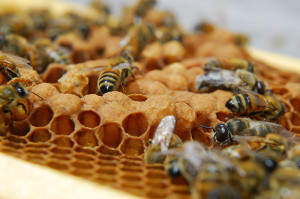
We considered culling Salvia’s drone brood, but at the moment these are the only drones in the entire apiary.
The newspaper was positioned on the top box of Salvia, and a few three inch slits were cut with a razor blade between, and parallel to, the frames. This helps to get the bees started chewing through the paper, and allows odors from both colonies to travel back and forth, while the bees adjust to each other’s presence.
Because the nuc colony was still in nuc boxes, and we don’t have a nuc introduction board, we set an empty hive body on top of the newspaper, and did a simple frame transfer from the nuc to the empty hive bodies. We ended up with two hive bodies containing the Salvia colony, and two containing the new Nuc colony with their Queen, and then added a final hive body full of nectar, and some capped honey, above.
We then put the nuc box back in its original location to capture the field workers that were out when we combined the hives. Very early the next morning we were able to dump those field workers into the top of the Saliva hive to rejoin their colony.
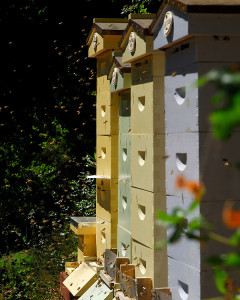
For a couple of days we left a small nuc box where the nuc colony had been before we combined the hives, so the nuc’s field workers had somewhere to return to
Now, we wait. Usually within 48 hours the bees from both colonies will be able to travel past the newspaper barrier. What we don’t know is whether or not there are two Queens, and if so, who will survive.
Obviously, if the failing Queen survives, this colony will be doomed, unless we intervene again, and introduce a mated Queen.
However, if the Nuc Queen prevails, we should see evidence of worker brood lower down in the Salvia hive within the next couple of weeks, as the new Queen resumes egg laying.
We will recheck the hive at that time, and if there is not significant evidence that the situation is improving, we will need to consider purchasing a mated Queen (as the Nuc is our only ‘extra’ mated Queen we have) as a last ditch effort to salvage the Salvia colony for this season. Of course, we’re hoping the nuc Queen survives and does well.
While we wait, we did harvest honey this weekend, that needs to be extracted, and bottled. More on that in our next post…

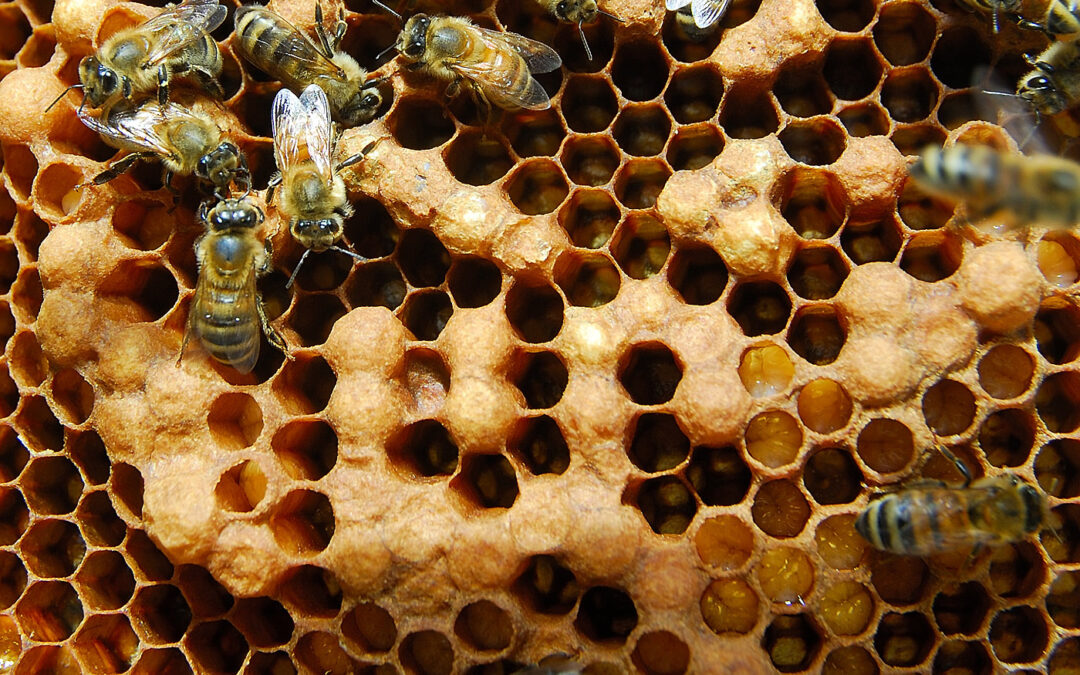

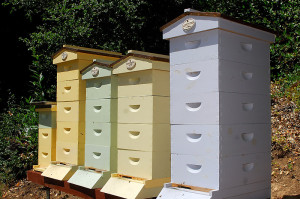

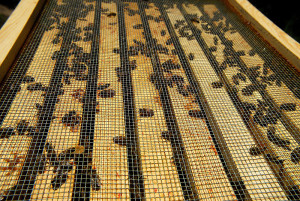

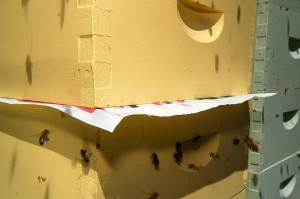








What a fascinating and complex world you’ve shown me! I’ve often thought that beekeeping would be fun, but it seems so daunting and involved. Don’t stop with the detailed posts though, because it’s great reading!
Every time I sit down to write a short post, it never quite works out that way. Beekeeping can be quite thought provoking sometimes. We really did have to think hard about what was going on with this hive. The fall is always a trickier time to sort out hives like this, as the bees need time to build back up before winter. Hopefully we got it right, and they’re now on their way to recovery.
Like Alan, I’m always fascinated by the view you give me into the complex world of beekeeping. It seems like a great deal of work, but a wonderful window on nature’s wonders. I hope your hive merger works out.
We didn’t look in the hives for a while, so it didn’t seem like much work at all. Of course, once we look, we usually find something in one of the hives that needs to be addressed 😉
Newspaper combines have been the most successful for me. I do hope you get them headed the right direction. it’s time, isn’t it? I’ll have to go into the hives this weekend.
It is time, if you want your summer honey that is 😉 It will be worth it when it’s done.
It really is fascinating and detailed work. I feel smarter over here.
Haha! I wish I felt smarter over here. Sometimes bees just remind me of how much I really don’t know! 😛
Clare, Great post! I did the same thing on Saturday to the daughter of our mother hive that was split in March. They kept requeening and crashing. Hive beetles almost took over. I killed 75 beetles and found about 50 larva on the screened bottom board. Need to check them soon. The newspaper is all over the ground in small pieces at the front of the hive.
I started to notice some newspaper yesterday at the entrance, so the bees must have broken through. It still seems calm by the hives, so hopefully not too much pandemonium broke out. I’m so glad we don’t have small hive beetle here. A couple of our guild members have seen a little of it, but their hives are close to creeks. I think our hives are so hot and dry during the summer, the beetles don’t really get established. I just hope it stays that way!
Wow! There is so much to know about bee keeping. Its an art! Thanks for your detailed info. I am now so informed!
I think that’s why I enjoy it. It’s both an art and a science, so that way both halves of my brain get a little exercise 😉
This is so fascinating! Each time I have a little honey with my tea, I have to think of the bees…
Me too! Those girls work HARD! 🙂
I don’t keep bees but I found this post fascinating.
Glad you enjoyed it Mary 🙂
I’m so glad you wrote this post now- in my last quick apiary check, I noticed that two of my hives don’t seem to have their act together. I’m still trying to figure out what exactly is going on with them, made more difficult by the fact that I am horrible at finding anything I am looking for, including, it would seem, queen bees. I think one has a laying worker- now I know what to look for! I had been thinking of throwing the two hives together using newspaper (plus chopped onion just to really throw off everyone’s sense of smell), but it looks like I should take a second look at the two hives before deciding what to do.
I’m not great at finding Queens, especially our feral Queens, as they’re so dark! I think you can tell a lot by brood type/pattern, presence of eggs (especially multiples), and presence or absence of supersedure cells. I’d always thought that a laying worker colony would be easy to spot. If I’d opened the lid, and seen mostly drones, maybe it would be, but there’s a lot of grey area where you really have to look critically at the frames to deduce what’s going on. Another possible scenario that I didn’t mention is that the colony already superseded the Queen, but that the new Queen isn’t yet laying, or has only just started to lay eggs. That’s the other situation where you may see pairs of eggs in some cells, but that usually works itself out in a few days. That colony though would likely be completely broodless (no drone brood either). I hope you just have weak, or superseded Queens. Managing laying worker colonies just seems like an enormous pain! 😉
Bee keeping really is complicated. I think I will continue to buy my honey at the farmer’s market and enjoy it vicariously through you blog.
Bees are complicated! Well, perhaps not so much if you’re a bee, but they do have a complex social order. I think what we’ve learned the most with beekeeping is to always expect the unexpected when doing a hive inspection, and be prepared for as many possibilities as is practical when heading out the hives. Even then though, sometimes the bees still manage to throw us a curve! 😉
Hello there! I too am in the process of assessing whether my hive has lost its queen…for the second time this season! Will do a check tomorrow and if there are no new brood or eggs will try to dig up a late season queen to purchase.
I do have a question though…what is your best method of doing an early spring split, which I hope to be able to do. Would appreciate a walk-through of the method.
Thanks for the very interesting and thorough blog entries!
The method we use for spring splits is what most beekeepers call a ‘walk-away’ split. It’s quite simple. You set up an empty hive or nuc to divide the colony into. Then you open the hive to be split. Assess food reserves (both pollen and honey), and work your way down to the brood nest. You want to see that the colony has really started to build up for spring.
The goal of the split is to divide the brood nest roughly in half. The most important thing is to be sure that you have eggs, young larvae, and capped brood, along with PLENTY of nurse bees to care for the brood until it hatches, in BOTH colonies at the end of the split. Eggs in BOTH the new colony, and the parent colony are critical, because if you accidentally move the Queen during the split, you MUST have eggs present for them to be able to raise a new emergency Queen.
You’ll also transfer a few frames of honey and a pollen frame into the new colony so they have food.
Close the hives back up. It will take approximately 16 days for the Queenless colony to make a new Queen, plus a few days (weather permitting) for her mating flight. A few more days to get the hang of egg laying, and then another 9-10 days to see capped brood in the new hive. Checking the new colony before you have capped brood obviously won’t tell you if you have worker brood, indicating a well mated Queen, or drone brood suggestive of an unmated/poorly mated Queen, so we wait, and don’t recheck the colony for about 5 weeks after the split (unless there’s noticeably something wrong at the hive entrance).
This post describes how we split the Salvia colony this last February during an early split. One caveat is that after you’ve split the parent colony, recheck that colony as well, not just to see if the Queen is ok, but to see how fast they’re building up. We split Salvia, and she built up so fast, she swarmed before we could split her again!